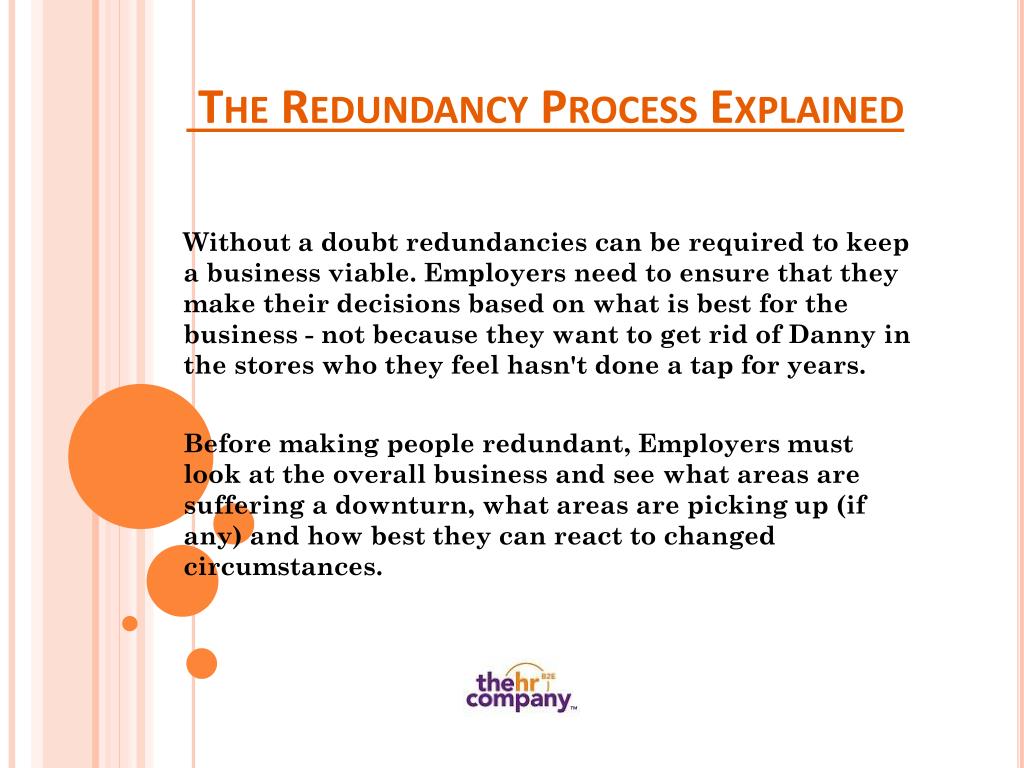Just How to Deal With Redundancy Pay If Company Goes Bust: Trick Info for UK Employees
Just How to Deal With Redundancy Pay If Company Goes Bust: Trick Info for UK Employees
Blog Article
Investigating the Interplay Between Business Redundancy and Organizational Adaptability for Future Growth
In the dynamic landscape of today's organization world, the complex relationship between company redundancy and organizational flexibility emerges as a vital variable for sustained growth and success. Business commonly encounter the challenge of striking a fragile equilibrium in between keeping a degree of redundancy to alleviate dangers and cultivating adaptability to respond swiftly to the ever-evolving market needs.
Importance of Firm Redundancy
Business redundancy is a critical aspect that enhances organizational strength and minimizes operational threats. By integrating redundancy steps within the business structure, business can better withstand unpredicted interruptions and fluctuations in the organization atmosphere. Redundancy offers as a critical buffer, permitting companies to adjust and respond efficiently to unexpected obstacles without jeopardizing important operations.
One secret element of the importance of firm redundancy is its function in making certain continuity during times of dilemma. When confronted with sudden changes or emergencies, repetitive systems, resources, or employees can step in to maintain crucial features and stop widespread disruptions. This continuity not just safeguards the firm's reputation and customer count on however likewise reduces financial losses and functional downtime.

Techniques for Business Flexibility

Producing versatile organizational structures that allow for fast adjustments to market dynamics and client needs is crucial for remaining affordable in a swiftly progressing environment. By proactively identifying potential disturbances and opportunities, companies can proactively adjust and thrive in an ever-changing organization landscape.
Harmonizing Redundancy and Versatility
Attaining an unified balance in between operational redundancy and business flexibility is vital in browsing the complexities of a dynamic business environment. Redundancy within a firm gives a safeguard, making certain connection and security in procedures. Nonetheless, an unwanted of redundancy can cause ineffectiveness and impede adaptability to changing market problems. On the various other hand, organizational flexibility permits firms to respond immediately to outside disturbances and seize new chances. Striking the ideal balance between redundancy and adaptability is a delicate procedure that requires a deep understanding of the organization's goals, market characteristics, and danger tolerance.
To attain this balance, business require to carry out normal assessments of their procedures to identify locations where redundancy is necessary for danger reduction and where flexibility can drive innovation and growth. Carrying out flexible frameworks, promoting a culture of continual knowing and enhancement, and encouraging open interaction across all levels of the company are key methods to balance redundancy and adaptability efficiently. By straightening these 2 important aspects, firms can position themselves for lasting growth and success in an ever-changing company landscape.
Instance Studies on Adaptation Success
In examining circumstances of effective business adjustment, it becomes apparent that the interaction between operational redundancy and flexibility is a defining variable in shaping resilient companies. One engaging study is that of Netflix. At first a DVD rental service, Netflix showed impressive adaptability by transitioning into a streaming platform when digitalization disrupted the market. By tactically spending in technology and content production, Netflix not just survived however thrived in a swiftly advancing market. One more standout instance is Amazon. Starting as an on-line book shop, Amazon constantly adjusted its service version, broadening right into varied industries such as cloud computing and expert system. This adaptability allowed Amazon to remain in advance of competitors and satisfy altering consumer demands. Last but not least, Adobe offers a notable picture of effective adaptation. The dig this business moved from selling software application licenses to a subscription-based design, ensuring recurring profits streams and enhanced consumer engagement. These case studies highlight the value of operational redundancy coupled with organizational flexibility in fostering lasting development and competition.
Building Resilience for Future Growth
Structure resilience for future growth requires a critical alignment of operational procedures with market characteristics and arising trends. Firms need to adjust to altering environments by cultivating a culture of flexibility, development, and continual enhancement. Strength involves not only getting better from obstacles however additionally proactively planning for future challenges. One crucial element of structure durability is buying durable danger administration strategies to minimize possible interruptions. This includes circumstance planning, expanding supply chains, and developing backup strategies for different backups (who pays redundancy money).
Moreover, promoting strong connections with stakeholders, such as consumers, staff members, suppliers, and the neighborhood, is vital for weathering uncertainties and maintaining count on and support throughout stormy times. Effective communication and openness play an important role in structure resilience, as they help line up assumptions and promote partnership in navigating uncertainties.
Furthermore, companies my link require to focus on learning and advancement campaigns to upskill staff members and equip them with the necessary devices to adapt to transforming scenarios. By buying their labor force, firms can enhance their flexibility and dexterity, eventually reinforcing their durability for sustainable future growth.
Final Thought
In the vibrant landscape of today's company globe, the elaborate relationship in between business redundancy and business adaptability emerges as a vital variable for find out here sustained development and success. Business often encounter the challenge of striking a fragile equilibrium between preserving a degree of redundancy to alleviate dangers and fostering flexibility to respond swiftly to the ever-evolving market needs.To accomplish this balance, firms need to carry out routine evaluations of their procedures to determine areas where redundancy is required for threat mitigation and where flexibility can drive advancement and growth.In conclusion, the interplay in between firm redundancy and organizational flexibility is important for future growth. Building durability via a mix of redundancy and versatility will make certain that companies are prepared for the challenges of the future.
Report this page